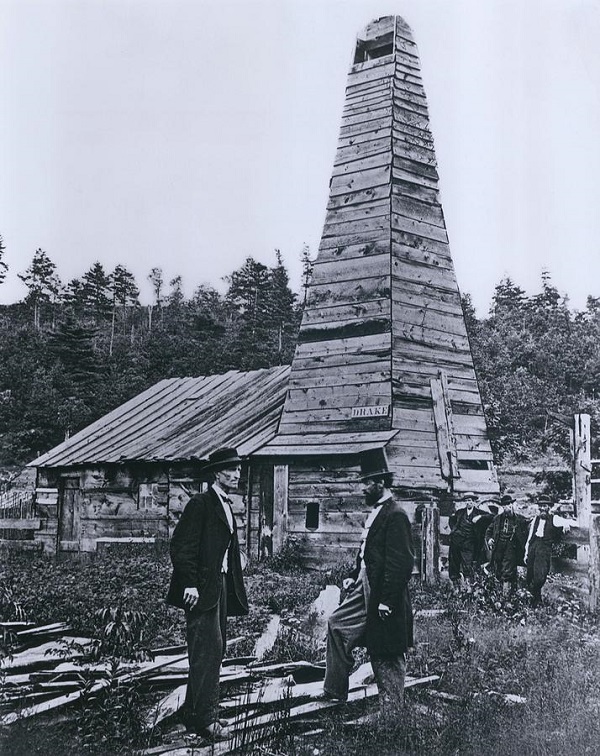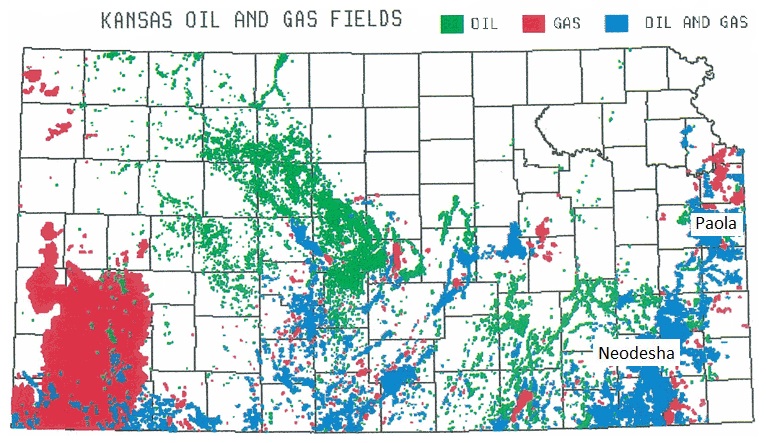An 1859 Pennsylvania well fueled kerosene lamps. A 1901 Texas gusher fueled autos. U.S. oil fueled victory in two world wars.
Petroleum history provides a context for understanding the modern energy industry. The American Oil & Gas Historical Society helps preserve this history, including first oil discoveries, which began in Pennsylvania. Thanks to its volunteers and supporters, AOGHS maintains an energy education network of museums, educators, researchers, and “oil patch” historians.
America’s petroleum industry officially began on August 27, 1859, with a commercial well drilled just 69.5 feet deep along Oil Creek at Titusville, Pennsylvania. That commercial oil discovery forever changed the U.S. economy, standard of living, and culture.
Eventually adopting a 42-gallon oil barrel, the earliest exploration companies sought oil for refining into lamp fuel. The refined “rock oil” — kerosene — was brighter and cheaper than whale oil and much safer than the popular fuel camphene, a danger for flashfires.

Edwin Drake, right, stands with friend Peter Wilson of Titusville, Pennsylvania, at the drilling site – but not the original cable-tool derrick – of the August 1859 first commercial U,S, oil well. Photo courtesy Drake Well Museum.
As oilfield discoveries grew, more states became “producing states,” and the political landscape changed as fast as the new industry’s exploration technologies. Early issues included need for an infrastructure for producing, storing, and transporting oil and natural gas.
As oilfield discoveries grew, the rush for black gold created state and national economic issues, including wasteful over-production, sudden collapses of oil prices, some questionable stock promotions, and frequent boom-and-bust cycles. New phrases arrived as “oil fever” encouraged investing in newly formed exploration companies that failed after the first “dry hole.”
The industry faced major challenges as the improved science of petroleum geology began finding Mid-Continent oilfields. Thomas Edison then invented the first practical incandescent light in 1879, which would remove demand for the oil industry’s principle product, kerosene.
Oil demand would continue for other refined products — see articles about the invention of Vaseline and Marlex plastics. There also was a famous children’s book author who once owned a business selling axle-grease.
Fortunately for exploration and production companies, automobiles powered by an internal combustion engine required what had been a refinery byproduct: gasoline. The first U.S. auto show took place inside New York City’s Madison Square Garden in November 1900. Less than two months later, a massive oilfield discovery at Spindletop, Texas, launched the modern U.S. oil industry.
First American Oil Well
American oil history begins in a woodland valley along a creek in remote northwestern Pennsylvania. Today’s U.S. petroleum exploration and production industry is born on August 27, 1859, near Titusville when a well specifically drilled for oil finds it. A former railroad conductor drilled it for New Haven Connecticut investors. Even more early U.S. petroleum history quickly arrived on the banks of Oil Creek: First Oil Well, First Oil Well Fire.
Spindletop launches Modern Petroleum Industry
The 1901 “Lucas Gusher” in Texas revealed the Spindletop oilfield, which would produce more oil in one day than the rest of the world’s oil fields combined. The Prophet of Spindletop — self-taught geologist Patillo Higgins — had founded the Gladys City Oil, Gas & Manufacturing Company in 1892 near Beaumont, Texas.
First Alabama Oil Well
Traces of natural gas had been found in Alabama in the 1880s, and gas was being supplied to Huntsville as early as 1902. Although tar pits had been reported in the 1850s, Alabama’s oil industry began when its first oilfield was discovered on February 17, 1944, by Texan H.L. Hunt, who drilled the No. 1 Jackson well in Choctaw County.
First Alaska Oil Well
The first Alaska oil well with commercial production arrived in 1902 in rugged territory where oil seeps had been known for years. Drilled using cable tools in 1902, the first Alaska oil well proved production was possible in the territory – but difficult and costly to transport.
The Alaska Steam Coal & Petroleum Syndicate produced the oil near the remote settlement of Katalla on Alaska’s southern coastline. The oilfield there also led to construction of Alaska Territory’s first refinery.
First Arizona Oil Well
Arizona became a petroleum-producing state in 1954 with a natural gas well drilled by Shell Oil Company. The first significant oil production arrived in 1959 with a well completed by the Texas Pacific Coal and Oil Company. Apache County in the northeast corner of the state remains the only petroleum-producing county.
First California Oil Wells
Following the August 1859 oil discovery in Pennsylvania, the young U.S. petroleum industry reached the West Coast in the late 1870s with the first California oil well. After drilling three wells beginning in 1875, California Star Oil Works struck the Golden State’s first oil gusher with the fourth well. The discovery would help create a major oil company.
First Florida Oil Well
Attempts to find oil in Florida began in 1901, not far from the Gulf Coast panhandle town of Pensacola. After decades of expensive dry holes, a frustrated state legislature offered a $50,000 bounty for the first commercial well, which was completed in 1943 by Humble Oil Company by present day Big Cypress Preserve.

Kansas petroleum reserves include the giant Hugoton natural gas (and helium) field discovered in 1919 in the southwestern part of the state. Map courtesy Kansas Geological Survey.
First Kansas Oil Well
While drilling for natural gas drilled on a garden plot belonging to T.J. Norman, a local blacksmith, the Norman No. 1 well found oil instead. Although the 1892 well of William Mills was a small producer in Neodesha, Kansas, it was the first major petroleum discovery west of the Mississippi River.
First Louisiana Oil Wells
In 1901, the first Louisiana oil well revealed the giant Jennings oilfield and launched the Pelican State’s petroleum industry. Hundreds of thousands of wells have been drilled since.
First Mississippi Oil Wells
The first Mississippi oil well was drilled in 1939 after a Yazoo County survey by geologist Frederic Mellen, who had sought a suitable clay to mold cereal bowls for children. Union Producing Company completed ithe Woodson No. 1 at Tinsley, a few miles southwest of Yazoo City. The well produced 235 barrels of oil a day from a depth of 4,560 feet from a sandstone later named the Woodruff Sand. While working on a Works Progress Administration project, Mellen had found indications of a salt dome structure.
First Nebraska Oil Well
The first publicized report of oil in Nebraska had been in an 1883 newspaper. After more than a half century of dry holes, Nebraska’s first commercial oil well was completed in the southeastern corner of the state. The Pawnee Royalty Company made the 1940 discovery west of Falls City in Richardson County.
First Nevada Oil Well
After nearly half a century and 85 dry holes, Nebraska’s complicated geology finally yielded a producing oil well. On February 12, 1954, Shell Oil Company completed the first commercial well. Shell’s Eagle Springs No. 1 found oil in Railroad Valley in Nye County.
First New Mexico Oil Well
New Mexico’s first commercial oil well is drilled September 25, 1922, on the Navajo Indian Reservation near Shiprock by the Midwest Refining Company. The Hogback No. 1 well is a modest producer at 375 barrels per day, but Midwest soon drills eleven additional wells to establish the Hogback oilfield as a major producer of the San Juan Basin.
First North Dakota Oil Well
After decades of dry holes drilled from one corner of the state to the other, in 1951 new technologies and determination – true grit – brought North Dakota’s first oil discovery. The exploratory well on the farm of Clarence Iverson northeast of Williston endured blizzards and was “shot” several times before finally producing oil on April 4, 1951.
First Oklahoma Oil Well
At 3 p.m. on April 15, 1897, in Indian Territory, George Keeler’s stepdaughter dropped the “go devil” down a well bore to set off nitroglycerin. A crowd watched as the explosion caused the Nellie Johnstone No.1 well to blow in as an oil gusher. Drilling had begun in January, the same month Bartlesville was incorporated – and a decade before Oklahoma became a state.
Another First Oklahoma Oil Well
After the Cherokee Nation in Indian Territory passed a law in 1884 authorizing organization of a company “for the purpose of finding petroleum, or rock oil, and thus increasing the revenue of the Cherokee Nation,” a well completed near oil seeps produced half a barrel of oil a day seven years before a more famous discovery well at Bartlesville. An oil well also was completed in 1888 by Dr. H.W. Faucett and the Choctaw Oil and Refining Company near Chelsea.
First Lone Star Discovery
On September 12, 1866, Lyne Taliaferro Barret brought in the first Texas oil well. His Nacogdoches County discovery produced just 10 barrels a day and failed. It lay dormant for nearly two decades until 1887 when others return to the small but historic oilfield.
First Texas Oil Boom
The first Texas oil boom arrived in the summer of 1894 when the Corsicana oilfield was discovered by a drilling contractor hired by the city to find water. Technological innovations would follow, including rotary drilling. Corsicana residents annually celebrate their town’s oil patch heritage with a Derrick Day Chili & BBQ Cook-Off.
First Utah Oil Well
After decades of frustration over failed exploration attempts, the first Utah oil well was competed on September 18, 1948, in the Uinta Basin. “The honor of bringing in the state’s first commercial oil well went not to the “Majors” but to an “Independent,” the Equity Oil Company,” notes one Utah historian.
First Wyoming Oil Wells
Tales of a Wyoming “tar spring” would inspire Mike Murphy of Pennsylvania to drill the state’s first significant oil well in 1883. Civil War veteran Philip Shannon explored more of the Salt Creek oil seeps outside of Casper. But the story of Wyoming’s oil patch really begins with Washington Irving.
—————————————
Explore more American Oil & Gas Historical Society articles
Following the 1859 launching of the U.S. oil industry in Pennsylvania, exploration and production moved westward — and created a new profession, petroleum geologists. In search of tax revenue, some states offered bounties to encourage drilling (see First Florida Oil Well). Others found none or small amounts of petroleum. Washington state had no significant oil production until Sound Cities Gas & Oil Company produced a little oil during the Great Depression. Learn more in Is My Old Oil Stock worth Anything?
Popular with Educators and Students
John Wilkes Booth and Dr. Seuss were once in the oil business; Maybelline cosmetics, Hula-Hoops, nylons, and Wax Lips were all petroleum product offspring; Harry Houdini patented a deep sea diving suit adopted by offshore drillers; “fracking” was the profitable brainstorm of a cashiered Union veteran; and countless thousands of obsolete stock certificates fascinate collectors — each a part of petroleum history, and offering a context for understanding the modern energy business.
Amazon Books Associates
Your Amazon purchase benefits the American Oil & Gas Historical Society. As an Amazon Associate, AOGHS earns a commission from qualifying purchases from these links: Highlighted History Books from Amazon; Education and Teaching Books
; Biographies and Memoirs
; Engineering and Transportation; Politics and Social Sciences.
—————————————
The American Oil & Gas Historical Society (AOGHS) preserves U.S. petroleum history. Please become an AOGHS annual supporter and help maintain this energy education website and expand historical research. For more information, contact bawells@aoghs.org. Copyright © 2025 Bruce A. Wells. All rights reserved.



